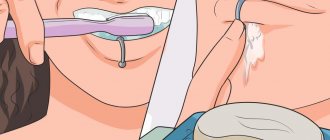Improper and irregular oral care means there is a high probability of getting some kind of infection, which can lead to gum disease. Gum papilloma is a form of oral disease that requires immediate treatment. It may also occur on the lips, tongue, larynx, and throat. Papillomas can be quite painful, and their development threatens inflammatory processes in the oral cavity.
Causes of papilloma
This disease is caused by papilloma, a viral infection that has a long latent, that is, hidden, period. The time during which the disease does not manifest itself after the virus enters the body takes from two months to five years. This is the main danger of such a disease, because in such cases immediate intervention by a surgeon is required, and delay can cause death. The main reason for the formation of papilloma on the gums is a decrease in human immunity.
Treatment methods for papillomas on the lip mucosa
Treatment of this pathology is prescribed individually. The best results are observed with combination therapy of papilloma on the lip mucosa. Drug treatment and physical destruction of the tumor are used. Sometimes traditional medicine methods can be used additionally. However, the latter cannot be the main treatment.
Medicines for papillomas on the lips inside the mouth
In the photo there are preparations for papillomas on the inside of the lip
Papillomas on the inside of the lip are essentially just a symptom of a viral infection that has affected the body. In addition, these tumors often recur, so for maximum treatment effectiveness, care should be taken to strengthen the body and strengthen its protective functions. For this purpose, antiviral and immunomodulatory therapy is used.
Let's consider the most popular drugs that are used in the treatment of papillomas on the inner lips:
- Antiviral agents . Good results are demonstrated by the following drugs: Isoprinosin (from 600 rubles), Panavir (about 1500-2000 rubles), as well as their analogues Groprinosin (from 600 rubles), Allokin-Alpha (from 3400 rubles). These medications help suppress the papillomavirus and reduce the viral load in the body.
- Immunomodulators . Strengthen the body's protective functions and help the immune system fight the pathogen. When treating human papillomavirus infection, the following drugs can be prescribed: Amiksin (about 650 rubles), Likopid (from 300 rubles) and their analogue Derinat (from 350 rubles).
Also, as part of general restorative drug therapy, multivitamin complexes and various dietary supplements can be prescribed.
In addition, before treating papillomas on the inside of the lip, you should review your diet and give preference to healthy and vitamin-rich foods so that the immune system works smoothly.
Methods for removing papillomas on the inner lips
Modern methods of destruction of tumors on the lips and mucous membranes are low-traumatic and quite effective. Currently, the following methods are used to remove papillomas on the lips of the mouth:
- Laser coagulation . A semiconductor laser is used, which evaporates unhealthy cells and, at the same time, cauterizes the capillaries to avoid blood loss and the spread of the viral agent. The removal procedure lasts several minutes under local anesthesia. After a few days, the crust disappears and no trace remains of the papilloma. The cost of laser removal of papilloma from the lip mucosa is 1550-2600 rubles in Russia and 370-700 hryvnia in Ukraine.
- Cryoremoval . This procedure uses liquid nitrogen, which is applied using applications or a special device to the pathologically altered area of the mucosa. The substance acts quickly and effectively, but the problem is that even a specialist can find it difficult to track the depth of penetration of liquid nitrogen into tissues. Therefore, burns are possible or there is a need for a repeat procedure. The price of cryoremoval of papilloma on the inner lips is 650-1650 rubles in Russia and 270-470 hryvnia in Ukraine.
- Electrocoagulation . A heating element is used that produces an electric current. Removal of the growth is carried out under local anesthesia, as this is a rather painful process. Suitable for eliminating neoplasms on a flat base or small papillomas on the inside of the lip. The cost of electrocoagulation is 1250-2500 rubles in Russia and 350-650 hryvnia in Ukraine.
- Radiosurgery . In this case, special radioknives or loops are used, which act pointwise, directly at the place where the growth attaches to the mucosa. A very precise and minimally invasive method of removal, rarely leads to recurrence and complications. Its cost is the highest. The price for radioremoval of papillomas on the lips of the mouth is 2500-3450 rubles in Russia and 650-1300 hryvnia in Ukraine.
In addition, various cauterizing chemicals , for example, acids, alkalis. However, these drugs should also be used only under the supervision of a physician, since the risk of burns and tissue necrosis is high.
- See also removal of papillomas by radio wave method or laser - which is better
Symptoms of the development of gum papilloma
Papilloma is a benign tumor in the form of a characteristic growth. This formation can come in different sizes and shapes. Papilloma on the gum may not manifest itself in the form of pain or discomfort that bothers a person. This growth can be detected when visiting the dentist with complaints about teeth or gums, when the doctor conducts a professional examination of the entire oral cavity.
Papilloma is felt by the patient as a foreign body, which, depending on its size, creates a feeling of discomfort. It prevents the free position and movement of the tongue, which provokes distortion of the speech apparatus. With a significant increase in papilloma on the gum, it becomes difficult to chew food.
Warts on the labia
Papillomas on the labia, warts on the mucous membrane of the inner walls of the vagina, vestibule and entrance are small growths, balls, peas, “icicles” of flesh color. In most cases, these formations do not arise singly - they are a number of structures that gradually unite into tumor-like growths in the form of growths, “cauliflower”, “grapes”, “papillae”, “fringe” or “cockscombs” on a narrow stalk of various sizes . Blood vessels pass through the leg to the formation, through which the genital neoplasms are nourished and, accordingly, grow.
They can be single, more often multiple - they gather in groups, often the papillae grow very strongly and merge with each other into large conglomerates. Here you can see photos of condylomas in women.
With this localization, genital warts can be damaged by tight clothing, during intimate contacts, cosmetic and hygienic procedures, etc. Constant trauma to the external genitalia stimulates the relatively rapid growth and spread of papillomas and condylomas from the labia deep into the body - into the vagina, cervix, urethra, anus and rectum.
Photo of papilloma and condyloma on the labia
Since the woman herself usually cannot detect small formations, they are most often detected during an external examination of the genitals by a gynecologist. Although in our practice it is not uncommon for a patient with a sufficient number of small condylomas on the mucous membranes of the external genitalia to be the first to report the presence of these warts, although before that she regularly (more or less) visited other gynecologists.
Forum about papillomas of the labia
- Reasons for appearance? Infection with the human papillomavirus, and then its appearance on the labia on one or both sides, is always provoked by one of several factors: a). sexual contact with a virus carrier (a condom does not always protect against infection, since during foreplay the genitals come into contact with each other); b). sharing personal hygiene items with an infected person; V). visiting the same bath or toilet with a sick person (warmth and moisture favor the virus and condylomas grow faster); G). mechanical injury to the mucous membrane of the labia minora during masturbation, petting, shaving, etc. followed by the introduction of the virus. Since HPV can remain viable for a long time in the air, it can become infected in baths, saunas, public swimming pools, solariums, if you sit on benches with your genitals bare and use other people’s personal hygiene products.
- What is the difference between a sick person and a virus carrier? There are virus carriers - women who do not have pronounced signs of papilloma on the labia. They themselves do not suffer from HPV, but are carriers. Through close household or sexual contact, primarily oral contact, transmission of the virus to a partner is possible. An infected person is likely to remain symptom-free for many weeks, months, or even years. Factors that suppress the immune system (surgeries, stress, colds, injuries, pregnancy, abortion) are the reasons for the activation of infection and the impetus for the growth of genital warts, incl. on the labia minora and majora.
- Types of genital warts? Depending on the nature of their growth, warts can have external growth (exophytic) or internal growth (endophytic). The first ones are pointed. They appear on the outside of the labia in the form of growths and papillae, fimbriae. Endophytic, so-called “flat condylomas” are growths that extend into the surface epithelium. Condylomas inside the labia are caused by a type of HPV with high oncogenic activity, and in women they often spread to the cervix.
- What symptoms might there be? After the introduction of infection or activation of the virus in the submucosa, the woman initially experiences unpleasant sensations: itching, itching, stinging, burning. After some time (from several hours to days), small papillomas form on the labia (multiple or single). Sprouts of new elements can spread through the capillary network to neighboring areas and appear on the clitoris, near the urethra and anus.
- Can girls and teenagers have papillomas of the labia or not? Warts on the genitals are not the exclusive prerogative of sexually active women. In approximately 25-35% of cases, HPV of the labia minora is transmitted through household contact and its clinical manifestations in the form of condylomas in virgins can be at any age, from childhood to older reproductive age.
- Can papillomas appear from masturbation? As is already known from what we read above, infection occurs in the presence of injuries to the skin or mucous membranes of intimate places (lips, clitoris, vestibule, and anus), through which the virus easily enters the body. Such microdamages occur under intense mechanical influence as a result of masturbation, petting, fisting, improper use of sex toys or similar improvised objects, which, if there is a virus on the affected object, can subsequently lead to the appearance of warts on the labia majora or minora.
What to do if there are papillomas on the labia, how to remove them?
- Visit a competent and attentive gynecologist;
- Undergo a complete gynecological examination;
- Do a vulvoscopy (a type of colposcopy);
- Get tested for HPV (Digen test);
- Get tested for “hidden” infections.
If warts are detected on the genitals, the patient is recommended to undergo blood tests for syphilis (genital warts on the labia must be distinguished from broad ones, which are a manifestation of syphilis) and HIV (decreased immunity may be a consequence of AIDS). The table below presents an approximate list of tests that a woman should undergo if she has papillomas or condylomas on her labia.
| Analyzes | Price | |
| HPV types 6/11 | Not really | 650 |
| HPV genotypes (16, 18, 31, 33, 35, 39, 45, 51, 52, 56, 58, 59) | typing | 2 350 |
| Blood tests for syphilis (RS), AIDS (HIV) | ELISA blood | 750 |
Removal of papilloma in the oral cavity
As a rule, removal of warts in the oral cavity is carried out using the radio wave method or using a laser. These two methods are the most effective, safe and painless (in some cases, local painkillers may be used). The essence of laser cauterization of papilloma is the impact of narrowly directed beams of a certain frequency, which leads to destruction and necrosis of pathologically altered tissues. Radio wave removal of warts involves cutting off the papilloma at its base, which allows the removed material to be sent for further histological examination.
The advantages of laser and radio wave treatment of papilloma include:
- Efficiency of the procedure;
- No postoperative scars;
- Minimal damage to surrounding healthy tissue;
- Short rehabilitation period;
- Possibility of removing warts of any size and location;
- No postoperative complications (bacterial contamination, spread of infection, bleeding).
There are also other destructive methods to combat warts in the mouth. These include:
- Cryodestruction (cauterization of papilloma with liquid nitrogen);
- Electrocoagulation (excision of warts with electric current);
- Cauterization of growths with chemicals;
- Surgical excision of papilloma using a scalpel.
However, due to the special sensitivity and increased humidity of the oral mucosa, the listed methods will be less effective and safe.
Contraindications for surgical treatment of warts include the presence of cancer, acute infectious viral pathologies, exacerbation of chronic diseases and diabetes mellitus in the decompensation stage.
The most effective and appropriate method of wart surgery is selected by the doctor after an examination. In this case, the specialist takes into account the age and health status of the patient, the presence of possible contraindications and allergic reactions, as well as the location, size and number of tumors.











